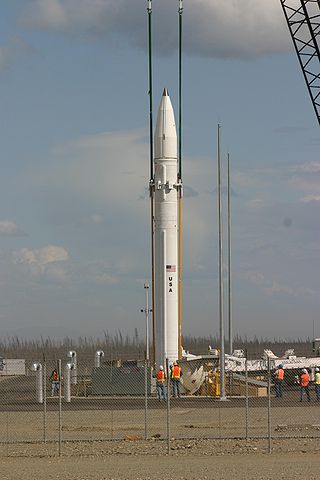
An anti-ballistic missile (ABM) is a surface-to-air missile designed to counter ballistic missiles. Ballistic missiles are used to deliver nuclear, chemical, biological, or conventional warheads in a ballistic flight trajectory. The term "anti-ballistic missile" is a generic term for a system designed to intercept and destroy any type of ballistic threat; however, it is commonly used for systems specifically designed to counter intercontinental ballistic missiles (ICBMs).
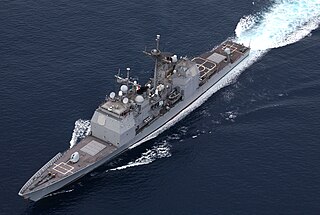
The Aegis Combat System is an American integrated naval weapons system, which uses computers and radars to track and guide weapons to destroy enemy targets. It was developed by the Missile and Surface Radar Division of RCA, and it is now produced by Lockheed Martin.
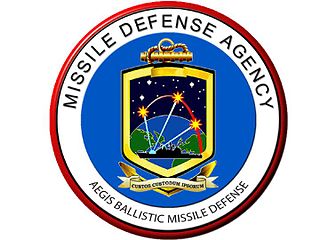
The Aegis ballistic missile defense system, also known as Sea-Based Midcourse, is a Missile Defense Agency program under the United States Department of Defense developed to provide missile defense against short and intermediate-range ballistic missiles. The program is part of the United States national missile defense strategy and European NATO missile defense system.

USS John Paul Jones (DDG-53) is the third Arleigh Burke-class guided missile destroyer in the United States Navy and the first ship of the class homeported on the west coast. She is the fifth ship named after American Revolutionary War naval captain John Paul Jones and the second to carry his first name. She was built at Bath Iron Works in Bath, Maine. The ship is part of Destroyer Squadron 9 of Carrier Strike Group 11, which is headed by the nuclear-powered aircraft carrier USS Nimitz (CVN-68).
The Rim of the Pacific Exercise (RIMPAC) is the world's largest international maritime warfare exercise. RIMPAC is held biennially during June and July of even-numbered years from Honolulu, Hawaii, with the exception of 2020 where it was held in August. It is hosted and administered by the United States Navy's Indo-Pacific Command, headquartered at Pearl Harbor, in conjunction with the Marine Corps, the Coast Guard, and Hawaii National Guard forces under the control of the Governor of Hawaii.

USS Lake Erie (CG-70) is a Ticonderoga-class guided missile cruiser of the United States Navy, commissioned in 1993. She was named after the U.S. Navy's decisive victory in the Battle of Lake Erie during the War of 1812. The cruiser was the first U.S. Navy ship to be commissioned in Hawaii.

The Kongō class of guided-missile destroyers in the Japan Maritime Self-Defense Force are equipped with the Aegis Combat System, and is the first of few ship classes outside the United States to have that capability. Following a decision made in December 2003, Japan is upgrading their Kongo-class destroyers with Aegis Ballistic Missile Defense System. The upgrade involves a series of installations and flight tests to take place from 2007 to 2010. JS Kongo was the first ship to have the BMD upgrade installed.

The Japan Maritime Self-Defense Force, abbreviated JMSDF, also simply known as the Japanese Navy, is the maritime warfare branch of the Japan Self-Defense Forces, tasked with the naval defense of Japan. The JMSDF was formed following the dissolution of the Imperial Japanese Navy (IJN) after World War II. The JMSDF has a fleet of 154 ships, 346 aircraft and 50,800 personnel.

The four De Zeven Provinciën-class frigates are air-defence and command frigates in service with the Royal Netherlands Navy. This class of ships is also known as "LCF". The ships are similar to the German Sachsen-class frigates in role and mission.
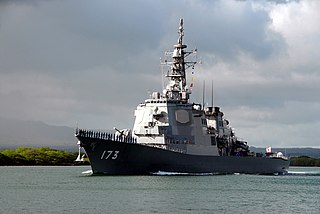
JS Kongō (DDG-173) is a Kongō-class guided missile destroyer in the Japan Maritime Self-Defense Force (JMSDF). Kongō is the third Japanese naval vessel named after Mount Kongō. She was laid down by Mitsubishi Heavy Industries in Nagasaki, Nagasaki on 8 May 1990. The launching ceremony took place on 26 September 1991 and she was commissioned on 25 March 1993. She was the first ship outside of the United States to feature the Aegis combat system and its ballistic missile defense capability.

JS Kirishima (DDG-174) is a Kongō-class guided missile destroyer in the Japan Maritime Self-Defense Force (JMSDF). Kirishima was named for Mount Kirishima. She was laid down by Mitsubishi Heavy Industries in Nagasaki, Nagasaki on 7 April 1992, and was launched on 19 August 1993.

JS Chōkai (DDG-176) is a Kongō-class guided missile destroyer in the Japan Maritime Self-Defense Force (JMSDF). Chōkai was named after Mount Chōkai. She was laid down by IHI Corporation in Tokyo on 29 May 1995 and was launched on 27 August 1996. Commissioning happened on March 20, 1998.

The RIM-161 Standard Missile 3 (SM-3) is a ship-based surface-to-air missile used by the United States Navy to intercept short- and intermediate-range ballistic missiles as a part of Aegis Ballistic Missile Defense System. Although primarily designed as an anti-ballistic missile, the SM-3 has also been employed in an anti-satellite capacity against a satellite at the lower end of low Earth orbit. The SM-3 is primarily used and tested by the United States Navy and also operated by the Japan Maritime Self-Defense Force.

The RIM-174 Standard Extended Range Active Missile (ERAM), or Standard Missile 6 (SM-6), is a missile in current production for the United States Navy (USN). It was designed for extended-range anti-air warfare (ER-AAW) purposes, providing capability against fixed and rotary-wing aircraft, unmanned aerial vehicles, anti-ship cruise missiles in flight, both over sea and land, and terminal ballistic missile defense. It can also be used as a high-speed anti-ship missile. The missile uses the airframe of the earlier SM-2ER Block IV (RIM-156A) missile, adding the active radar homing seeker from the AIM-120C AMRAAM in place of the semi‑active seeker of the previous design. This will improve the capability of the Standard missile against highly agile targets and targets beyond the effective range of the launching vessels' target illumination radars. Initial operating capability was planned for 2013 and was achieved on 27 November 2013. The SM-6 is not meant to replace the SM-2 series of missiles but will serve alongside and provide extended range and increased firepower. It was approved for export in January 2017. An air-to-air variant of the SM-6, known as the AIM-174, is the first dedicated long-range air-to-air missile employed by the USN since the 2004 retirement of the AIM-54 Phoenix. SM-6 can also be fired from the U.S. Army's Typhon missile launcher as part of the Strategic Mid-range Fires System (SMRF).

Terrier Oriole is an unguided two-stage rocket system which is primarily used by the Goddard Space Flight Center out of the Wallops Flight Facility as a sounding rocket. The system uses a Terrier first-stage booster attached to an Oriole second-stage rocket. The system can carry payloads between 800 and 1,500 pounds up to an altitude of 320 kilometres (200 mi). It is also used to test ballistic missile defense systems, under the name ARAV-B.
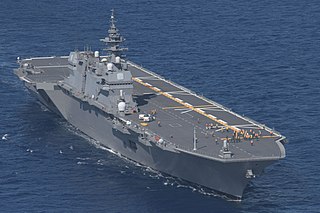
JS Izumo (DDH-183) is a helicopter carrier which, as of 2022, is being converted into a light aircraft carrier. Officially classified as a multi-purpose operation destroyer, she is the lead ship in the Izumo class of the Japan Maritime Self-Defense Force (JMSDF). She is the second warship to be named for Izumo Province, with the previous ship being the armored cruiser Izumo (1898).
The following lists events that happened in 2013 in the Democratic People's Republic of Korea. In 2013, tensions between North Korea and South Korea, the United States, and Japan escalated because of United Nations Security Council Resolution 2087, which condemned North Korea for the launch of Kwangmyŏngsŏng-3 Unit 2. The crisis was marked by increased rhetoric by the new North Korean administration under Kim Jong-un and actions suggesting imminent nuclear attacks against South Korea, Japan, and the United States.

The Maya class of guided-missile destroyers in the Japan Maritime Self-Defense Force is a modified version of the Atago class, with an updated Aegis Combat System and electric propulsion system. Maya was commissioned on March 19, 2020. Haguro was commissioned on March 19, 2021.

JS Maya (DDG-179) is the lead ship of her class of guided missile destroyer in the Japan Maritime Self-Defense Force (JMSDF). She was named after Mount Maya and shares her name with a World War II heavy cruiser.
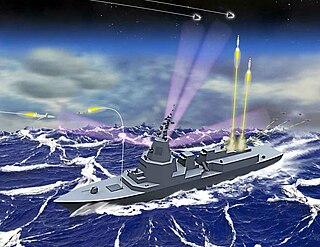
Aegis system equipped vessels (ASEV) or (Japanese: イージス・システム搭載艦) are a pair of ballistic missile defense (BMD) warships under construction to be operated by the Japanese Maritime Self-Defense Force (JMSDF) as dedicated sea-based BMD platforms, serving as an alternative to Japan's now-cancelled land-based Aegis Ashore BMD system.



















